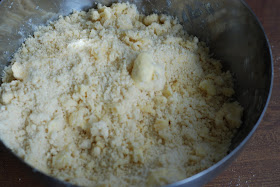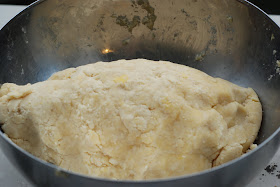It only begins to feel like a Chinese New Year, when I start the process of making pineapple tarts. Even though it's tedious, there's something cathartic about it, like the slow shedding of a year into the next, with the stamping of each tart. I always try to involve friends in this process, not just because it helps with the workload (hehe) but because it's such a good way to sit and talk for awhile. I find that I have to find new pineapple victims every year though because most of my friends have wised up to my schemes.
This year, I was privledged to have M. and S. come by to help with the stamping and filling of tarts. I had already made the jam, as described in previous posts here and here and S. asked for the recipe for the light and crusty dough, so here it is, in pictures. There are subtle differences between this recipe and the previous ones linked for pineapple tart dough, that's becuase over the years I've refined my proportions somewhat.

Step 1: Chop up 2 1/4 blocks of cold unsalted butter (250grams each) and add it to 1kg of sifted plain all-purpose flour. I try to use a European butter like President, Lurpak or Elle et Vivre, given how much butter goes in! For the flour, I use a regular Prima flour, I have used some premium brands before but don't really find that it makes that much difference. Add a pinch of salt.

Step 2: Rub the butter into the flour until it resembles breadcrumbs. If you start with small pieces of butter, or even grated butter, this will be a much easier process but I'm usually too lazy. Your butter should be cold though, to make it easier to slice up and to prevent the dough from melting into a soft lump.

Step 3: Add 4 egg yolks and 1 egg white, beaten together lightly, 1 1/2 Tablespoons of ice-cold water and the juice of 3 limes. I like to freeze a shallow bowl of water before I begin making the dough, then remove it to thaw after I've rubbed in the dough. This ensures that the water is really ice cold.

Step 4: Mix well into the batter. This is also where, if you like, you can add 1/2 teaspoon of vanilla essence or vanilla seeds for the taste.

Step 5: Try to knead the dough as little as possible, stop as soon as it all adheres together, to prevent a tougher texture.

Step 6: Divide the balls of dough into 4-5 seperate pieces.

Step 7: Flatten the dough within clingwrap. This makes it easier to store, to freeze (the dough can be frozen for 3 months and if you are intending to keep it raw for more than 3 days in the fridge, you should freeze it) and then to roll out (still within clingwrap) then stamp, neatly.
Thanks for the sharing of the recipe for Chinese New Year Pineapple Tart Dough. May I know what is the purpose of adding the juice of 3 limes?
ReplyDeleteHi, this is an interesting recipe with adding the limes...Any reason why there is no need for icing sugar? Thanks in advance!
ReplyDeleteHi,
ReplyDeleteIcing sugar basically gives your dough the same break-y crust-y but pale coloured texture as melting moments (a children's biscuit made of icing sugar). It will also make the dough uncomfortably sweet, somewhat malleable (which is not nice in a mouth-feel) and fine textured.
The limes will achieve the same crustiness but without making it simply powdery and so sweet. I think it's a much better way to achieve the right crumble consistency and also to kill off the 'eggy' taste that your dough will otherwise have.